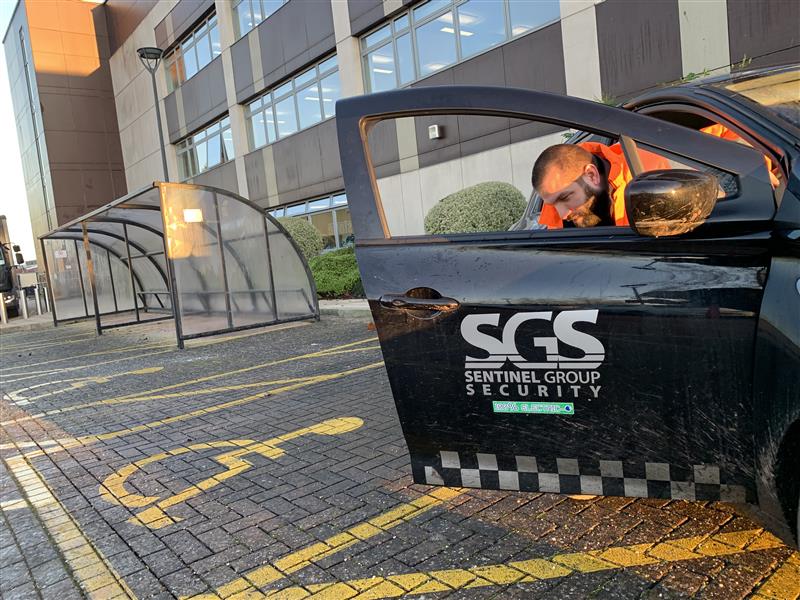
At SGS, we’ve heard it a hundred times, probably more.
“Can we cut back to just CCTV overnight?”
“Do we really need an officer here all night?”
“Could we just have a response service instead of someone on site?”
And the big one:
“How can we save money on our out-of-hours security?”
It’s a fair question. In fact, it’s a smart question. Every client we’ve ever worked with, big or small, has had to ask it at some point. After all, it’s not cheap to run a security team round the clock. Having Night-time security cost more, the risk looks lower after hours, and technology has come a long way in the last few years.
But here’s the thing: the answer is rarely as simple as “yes” or “no.”
So, in this blog, we want to talk honestly and openly about it, from our side of the fence. We’ll share real stories, lessons learned, and the things most people don’t consider until it’s too late. Because when it comes to out-of-hours security, the real question isn’t “can we save money?”.
It’s “what are we risking if we do?”
The Real Cost of Security – And the Pressure to Cut It
We get it. Every year, budgets tighten. Whether you’re a school, NHS site, office block or construction company, your finance team is probably looking at the bottom line and wondering where the cuts can be made.
Security often stands out. It’s a visible cost. It runs quietly in the background, especially after hours. And when nothing goes wrong, it can look like overkill. We’ve had clients come to us and say, “We’ve had no incidents in three years, do we really need an officer on site overnight?” It’s a fair point.
But here’s something we always ask back:
- Is that no incidents because of on-site security officers, or in spite of them?
- It’s a bit like home insurance. You don’t celebrate never making a claim by cancelling the policy. You see it as peace of mind that worked. The same logic applies here.
Still, we’re not in the business of scaring people into keeping services they don’t need. Quite the opposite. We believe in right-sizing security, using the best mix of people, tech, and processes for your site, your risk, and your reality.
What Are You Really Getting With a Night Officer?
Let’s take a quick moment to think about what a night officer actually does. They’re not just a warm body by the front door. A good security officer is:
- Doing hourly patrols, checking for unlocked doors or signs of intrusion.
- Watching for water leaks, fire risks, or equipment faults.
- Supporting lone workers, engineers, cleaners or staff working late.
- Spotting suspicious behaviour before it becomes a problem.
- Being a visible deterrent that stops people trying their luck.
- Calling emergency services immediately when needed, sometimes even saving lives.
One of our officers recently found a burst pipe in a council building at 2am. Water pouring down three floors, soaking into electrical cabinets. He shut off the mains and called the out-of-hours contact. Damage was minimal, business opened as normal the next day.
Without them?
That would have been a significant insurance claim and weeks of disruption.
The Tech Temptation: CCTV, Alarms & Response Services
So why do so many clients still want to cut night staff?
Technology.
CCTV cameras can see in the dark. Alarms can detect movement. Access control can lock every door. Mobile response teams can be dispatched within minutes. And it’s all cheaper, much cheaper, than paying someone to sit in a control room overnight. We’ve helped plenty of clients make the switch. For the right site, it makes sense.
Take a small office building in Pendle. Low footfall, alarmed, with 24/7 CCTV connected to our monitoring team in Loughton. We removed overnight officers, increased patrols to every three hours, and installed thermal cameras around the perimeter. We saved the client £000s a year. Two years on? Not a single incident.
Or consider a large warehouse in the Midlands. The client wanted to cut their three-person night shift. We redesigned their system, added external beams, linked fire and intruder alarms, and provided key holding with guaranteed 30-minute response. There was one incident in year one, our mobile team caught the intruder and passed him to police. The system paid for itself overnight.
But… What Happens When Things Go Wrong?
Now for the flip side.
We had a retail park who made the move too quickly. They removed all night officers and relied on monitored CCTV. One evening, a gang used crowbars to smash into one of the units. The camera spotted it, yes, but the callout took too long. By the time the mobile responder arrived, they were gone. £000s worth of tools, gone. The footage was grainy, and the police had little to go on. A few weeks later, they asked us to reinstate officer patrols between midnight and 5am.
We’re not sharing this to scare anyone, it’s just what happens when cost is the only driver. There’s a balance to be struck between coverage, speed, and presence. Sometimes tech is enough. Sometimes it isn’t.
What Do Insurers Say?
Here’s a question we always encourage clients to ask:
What does your insurer expect?
Because if you change your security setup without telling them, you might be in trouble when something does go wrong.
We worked with a manufacturing site in Yorkshire whose insurer insisted on on-site presence due to the value of stock and the risk of fire. The client wanted to switch to remote monitoring to save money. We brought in the insurer, reviewed the site together, and came up with a compromise, keep one officer on site, reduce their hours slightly, and boost the tech with new fire panels, cameras, and response triggers. The client saved money, the insurer stayed happy, and everyone slept a bit better.
The Human Element Can’t Be Replaced
It’s worth saying: no matter how good tech becomes, it can’t replace instinct.
- A camera can detect movement—but it can’t tell if it’s a fox or a teenager.
- An alarm can sound—but it won’t calm a panicked staff member.
- A remote operator can call someone—but they can’t run down a corridor to stop a fire.
We had a college client where a student stayed late working on a project. Around 10:30pm, she fainted in the hallway. The security officer found her during his routine patrol, called an ambulance, and waited with her until help arrived. Her parents sent us a handwritten thank-you card.
Could a camera have done that? Not even close.
When Hybrid Security Models Works Best
There is a sweet spot between having someone on site all the time, and going fully remote. Shared cover models are becoming more popular. Think of a group of buildings, say, an industrial estate, a group of schools, or NHS clinics. Instead of one officer per building, you have a mobile team doing timed patrols, supported by cameras and alarms. You still get boots on the ground, just not all the time.
This approach works well where risks are moderate but visible presence still matters. We’ve rolled out this model in several locations, including a housing estate in Burnley and a business park in Slough. The key is good planning, strong response times, and clear reporting.
How MiSentinel Helps Keep It All Connected
At SGS, we don’t just throw guards or cameras at a problem and hope for the best. We use MiSentinel to pull everything together. It’s our digital platform that tracks officer patrols, manages incidents, schedules mobile responses, and connects to our National Operations Centre. Whether you have a person on site or a triggered alarm, everything is logged, timestamped and visible to you.
So even if you reduce hours, you never reduce oversight.
So, What Should You Do?
There’s no one-size-fits-all answer. But here’s what we suggest if you’re thinking about reducing out-of-hours officer levels:
- Start with a proper risk review: Let us walk the site with you. We’ll look at current risks, past incidents, staffing patterns, and local crime data.
- Talk to your insurer: Before you make changes, ask what’s required. We’ll help translate security speak into insurance terms, so everyone’s clear.
- Think about your staff and users: Do people work late? Are there lone workers? Does a visible officer make them feel safe?
- Test your tech: Do your cameras work in low light? Are your alarms linked to a 24/7 monitoring team? Can responders get to you in time?
- Consider shared cover or hybrid models: You don’t have to go all or nothing. Let’s build a model that suits your budget and your risks.
It’s About Balance, Not Just Budgets
Here at SGS, we know our job is to protect what matters. And yes, that means doing it in ways that are smart, efficient, and value for money. But it also means asking the right questions, not just cutting costs because the building looks quiet after 6pm.
Security is about confidence. It’s about knowing someone’s looking out for your site when no one else is around. Whether that’s a camera, a key holder, or a trusted officer walking the floors, it needs to work. And it needs to work for you.
So, if you’re thinking about scaling back your night-time cover, let’s talk first, discuss a Security risk assessment. We’ll help you make the right call, not just the cheapest one.
Got questions about your out-of-hours cover? Want a free site review or to chat about new options?
- Drop us a line at info@sgs-ltd.com
- Visit www.sgs-ltd.com
- Or give us a call 0208 514 6565 — we’re here, day or night

